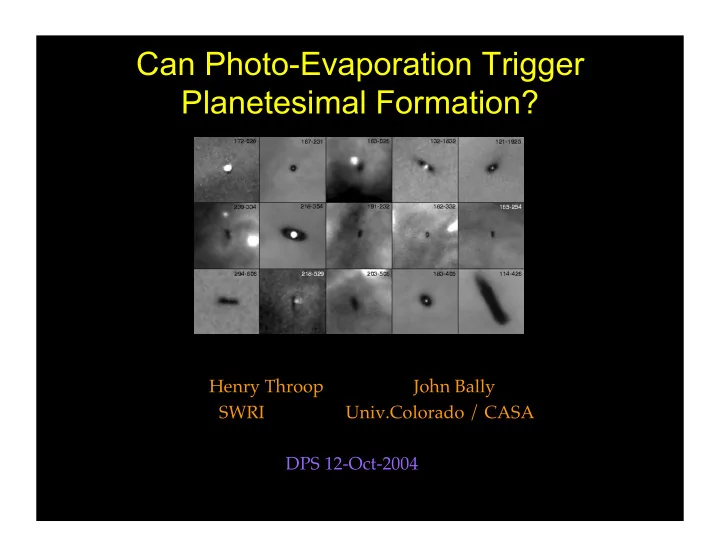

Can Photo-Evaporation Trigger Planetesimal Formation? Henry Throop John Bally SWRI Univ.Colorado / CASA DPS 12-Oct-2004
Orion Nebula Photo-evaporation (PE) by Photo-evaporation by extrnal O and B stars external O/B stars removes disks on 10 5 -10 6 yr timescales. OB associations like Orion are 4 O/B stars, rare but large – majority of UV-bright, star formation in the galaxy 10 5 solar probably occurs in regions luminosities like this. 2000 solar-type stars with disks
Photo-Evaporation and Gravitational Instability • Problem: Planetary formation models explain grain growth on small sizes (microns) and large (km) but intermediate region is challenging. • Youdin & Shu (2002) find that enhancing dust:gas surface density ratio by 10x in settled disk allows gravitational instability of dust grains to form km- scale planetesimals. • Can photo-evaporation (PE) encourage this enhancement, and thus allow the rapid formation of planetesimals?
Model of Photoevaporation • Our model is the first to examine dust and gas separately during photo-evaporation, and is the first to incorporate GI into photo- evaporation calculations. • 2D code which tracks gas, ice, dust around solar-mass star. • Processes: – Grain growth (microns-cm) – Vertical settling – Photo-evaporation – Dust gravitational instability • Photo-evaporation heats gas and removes from top down and outside in – Gas is preferentially removed – Dust in midplane is shielded and retained
Effect of Sedimentation on PE • Case I: Dust and gas well- mixed (no settling); 0.02 M sol • Model result: Disk is evaporated inward to 2 AU after 10 5 yr
Effect of Sedimentation on PE Hashed: critical density for GI • Case I: Dust and gas well- • Case II: Dust grows and settles to midplane mixed (no settling); 0.02 M sol • Model result: Disk is evaporated • Model result: Disk is inward, but leaves significant amount evaporated inward to 2 AU of dust at midplane (40 Earth masses after 10 5 yr outside 2 AU) • Dust has sufficient surface density to collapse via GI
Modeling Results Timeline • Photo-evaporation can sufficiently deplete gas in 2-100 AU region to allow 0 yr: Low-mass star with disk forms remaining dust to collapse via GI. 10 5 yr: Grains grow and settle • Gas depletion depends on a sufficient quiescent period ~ 10 5 yr for grains to 10 5 yr: O stars turn on settle before photo-evaporation begins. 10 6 yr: Gas disk is lost, allowing • Disk settling depends on low global planetesimals to turbulence, and is not assured. form from disk
Conclusions • Photo-evaporation may not be so hazardous to planet formation after all! In this model, it actually encourages planetesimal formation. • Did Solar System form near an OB association? – Rapid gas dispersal may not allow for formation of giant planets. – Final distribution of rock, ice, gas may depend strongly on time of O stars to turn on, and speed of disk dispersal.
The End
Star Formation and Photo-Evaporation (PE) • The majority of low-mass stars in the galaxy form near OB associations, not in dark clouds (ie, Orion is the model, not Taurus) • PE by FUV and EUV photons removes disks from outside edge inward, on 10 6 yr timescales. • PE is caused by external O and B stars – not the central star. • In Orion, typical low-mass star age is 10 6 yr, but O star age is 10 4 yr – disks have had a quiescent period before PE begins.
Implications • Coagulation models of grain growth have difficulty in the cm-km regime. This model allows for that stage. • Model explains how planets could be common, in spite of fact that majority of low-mass stars form near OB associations.
Organics
Recommend
More recommend